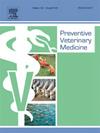实时PCR检测实际样本副结核的准确性:一项系统综述和荟萃分析。
IF 2.2
2区 农林科学
Q1 VETERINARY SCIENCES
引用次数: 0
摘要
副结核病是一种影响反刍动物的传染性和慢性疾病,每年给畜牧业造成重大经济损失。早期诊断和及时扑杀是控制该病的主要措施,这突出表明需要准确和快速的诊断方法。本系统综述和荟萃分析旨在评估定量PCR (qPCR)在副结核诊断中的有效性。我们从PubMed、Web of Science、Elsevier ScienceDirect、Wiley-Blackwell、Springerlink、AGRICOLA和CAB Abstracts等数据库中检索并选择文章,采用VETQUADAS (VQ)评估文献质量。采用“R”软件中的“Meta4diag”软件包、Meta-Disc 2.0和Meta-Disc进行meta分析和异质性调查,采用Deeks检验检测发表偏倚。纳入系统评价的研究显示出中等程度的异质性(I²= 48.6 %),无显著的发表偏倚(p = 0.998)。合并敏感性为0.92[95 %置信区间[CI], 0.85-0.96],特异性为0.85[95 % CI, 0.77-0.91],总受试者工作特征曲线下面积(SROCAUC)为0.95[95 % CI, 0.91-0.98]。这些结果表明,qPCR方法对动物副结核有较高的诊断价值。亚组分析显示这些研究的稳定性令人满意;然而,目前的单靶点qPCR检测策略仍然存在局限性,不能同时保证灵敏度和特异性。未来的发展应侧重于多靶点检测策略,为控制副结核提供更可靠的qPCR检测方法。本文章由计算机程序翻译,如有差异,请以英文原文为准。
Accuracy of real-time PCR for the detection of paratuberculosis in actual samples: A systematic review and meta-analysis
Paratuberculosis, an infectious and chronic ailment that affects ruminants, causes significant annual economic losses to the livestock industry. Early diagnosis and prompt culling are the primary measures for controlling this disease, highlighting the need for accurate and rapid diagnostic methods. This systematic review and meta-analysis aimed to evaluate the efficacy of quantitative PCR (qPCR) in the diagnosis of paratuberculosis. We searched for and selected articles from databases including PubMed, Web of Science, Elsevier ScienceDirect, Wiley-Blackwell, Springerlink, AGRICOLA, and CAB Abstracts, with VETQUADAS (VQ) employed to assess the quality of the literature. Meta-analysis and heterogeneity investigation were conducted using the “Meta4diag” package in “R” software, Meta-Disc 2.0, and Meta-Disc, while the Deeks’ test was utilized to detect publication bias. The studies included in the systematic review displayed a moderate level of heterogeneity (I² = 48.6 %) with no significant publication bias (p = 0.998). The pooled sensitivity was determined to be 0.92 [95 % confidence interval [CI], 0.85–0.96], and the specificity was 0.85 [95 % CI, 0.77–0.91], with a summary receiver operating characteristic area under the curve (SROCAUC) of 0.95 [95 % CI, 0.91–0.98]. These findings indicate that the qPCR method has high diagnostic value for identifying paratuberculosis in animals. Subgroup analysis revealed satisfactory stability in these studies; however, the current single-target qPCR detection strategy still has limitations, as it fails to simultaneously ensure both sensitivity and specificity. Future developments should focus on multi-target detection strategies to provide more reliable qPCR testing methods for controlling paratuberculosis.
求助全文
通过发布文献求助,成功后即可免费获取论文全文。
去求助
来源期刊

Preventive veterinary medicine
农林科学-兽医学
CiteScore
5.60
自引率
7.70%
发文量
184
审稿时长
3 months
期刊介绍:
Preventive Veterinary Medicine is one of the leading international resources for scientific reports on animal health programs and preventive veterinary medicine. The journal follows the guidelines for standardizing and strengthening the reporting of biomedical research which are available from the CONSORT, MOOSE, PRISMA, REFLECT, STARD, and STROBE statements. The journal focuses on:
Epidemiology of health events relevant to domestic and wild animals;
Economic impacts of epidemic and endemic animal and zoonotic diseases;
Latest methods and approaches in veterinary epidemiology;
Disease and infection control or eradication measures;
The "One Health" concept and the relationships between veterinary medicine, human health, animal-production systems, and the environment;
Development of new techniques in surveillance systems and diagnosis;
Evaluation and control of diseases in animal populations.
 求助内容:
求助内容: 应助结果提醒方式:
应助结果提醒方式:


